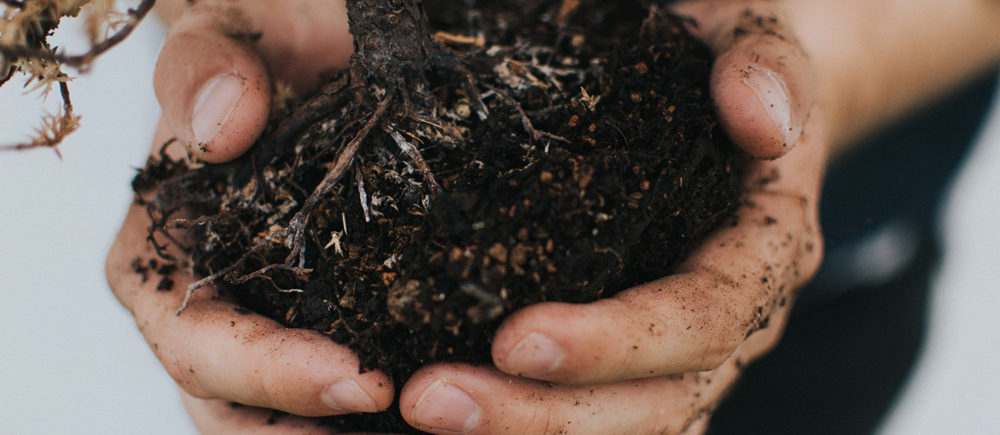Soil is the guardian of the carbon cycle, it is where climate and food really bind together. Soil is the largest carbon sink after oceans and can store much more carbon than trees and other vegetation. That is why human activities that release carbon from soil, like land-use change and agriculture, have a high impact on climate change. In fact, land-use change and agriculture are responsible for roughly one-third of greenhouse gas emissions globally.
At the same time, although we tend to forget, we can hardly grow any food without soil. The more carbon is in the soil – the more fertile it is. Most of the soil organic carbon is stored in the upper soil layer, the upper 30 cm, which also the layer where farming happens.
Historically, agriculture has relied on tillage – mechanical agitation of soil, involving digging, stirring and overturning of soil in order to get carbon closer to the surface to get better farming conditions. This method releases a lot of soil carbon into the atmosphere, contributing to the amount of greenhouse gases and depleting the soil.
Reducing tillage intensity is supposed to seal soil carbon, withdrawing it from the atmosphere and allowing it to build over time in the soil. The assumption is that no-tillage agriculture would allow perennial plants to grow, developing deeper roots that would add carbon to soil layers below the topsoil.
That is why low- or no-tillage farming has been proposed as a way to reduce net carbon emissions. For instance, FAO approximates sustainable soil practices can sequester 10% of the anthropogenic emissions in 25 years. Many countries bet on sustainable soil management in their climate mitigation strategies. Low-tillage is often promoted as a “two-birds-one-stone” strategy because, apart from the climate benefits, sealing carbon in soil is supposed to contribute to sustainable food security.
But is that really so? Can low-tillage deliver on these promises?
Recent study by researchers from the Swedish University of Agricultural Sciences (SLU) and Mistra Council for Evidence-Based Environmental Evidence (EviEM) suggests that sequestration effects of low-tillage agriculture can be limited only to the topsoil. Though, these conclusions only stand for boreal and temperate regions.
The analysis was based on the studies compiled in the Systematic Map published in 2015. This map presents academic and grey literature on the impacts of any sort of cropland management interventions on soil carbon across temperate regions. By extracting the data compiled in the Systematic Map, the authors were able to compare high-, low- and no-tillage methods using meta-analysis.
It is not the first time the effect of tillage on soil carbon is reviewed and analyzed. However, the researchers from SLU and Mistra EViEm found that most of the previous studies did not include deeper soil layers and calculated the carbon stocks based on fixed depths of the soil layers. The latter causes biases in data analysis because the soil bulk density and, consequently, the soil mass within a fixed layer may be different when tilled, comparing to when no tillage is applied. The bias resulting from ignoring the soil mass might even be larger than the differences introduced by tillage.
Excluding measurement of soil bulk density, a key soil function parameter that indicates soil compaction, can distort the results of analysis. For instance, high bulk density indicates low soil porosity and compaction which may cause restrictions to root growth, limiting the accumulation of soil carbon.
“To overcome this problem, we used the “equivalent soil mass” approach (ESM) which compares the same mass of soil per depth layer in all experimental treatments”, says Katharina Meurer, one of the authors.
The result is a more robust assessment of soil ability to accumulate carbon. Meurer and Haddaway acknowledge that reduced tillage has many beneficial effects on the environment. However, the results of their study mean that climate mitigation effects of low and no tillage soil management have previously been overestimated. Appears that low-tillage increases soil bulk density, making it more compact, especially in deeper layers.
The researchers point out they struggled with data availability – only 21 % of the studies included in the analysis reported both soil organic carbon and soil bulk density for the same depths, the two parameters necessary to complete assessments using the ESM approach.
“The main message of our results is for the scientist. We highlight it is necessary to sample soil in deeper layers. Otherwise we will continue to overestimate the impact of conservational tillage. At the same time, we encourage the scientific community and especially research institutions to report data on both soil organic carbon and soil bulk density together with the respective variances. We believe this will improve future analyses and contribute to the attempts of answering the remaining questions about the effect of tillage on soil’s carbon storage”, concludes Meurer.
When asked about the effects of low-tillage on food security, Meurer comments that it has been already shown in various studies that the yields can be lower under no tillage than when soil is tilled. The tillage does not only loosen the soil, but also prevents weeds from growing. Under no tillage treatments, farmers often have to use pesticides to fight weeds.
All in all, this new research shows that we still have a lot to figure out about the ways we can use soil as a carbon sink and that low-tillage, promoted by the proponents of conservational and climate-smart agriculture, is not a definitive soil-based solution to climate mitigation and food security. On the other hand, more sophisticated data and analysis of soil make it possible to correct our assumptions and provide an incentive to look for new solutions.
